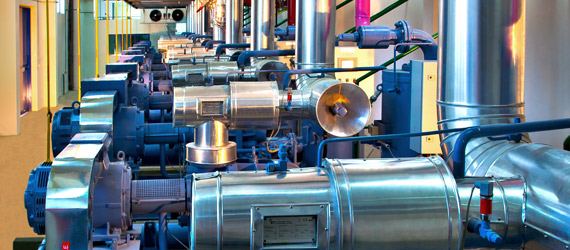 Traditionally, the goal of a carefully planned, proactive preventive maintenance program for centrifugal chillers has been to improve chiller reliability and increase equipment life. Experience showed that a well-organized schedule for routine checkups and minor repairs reduced the frequency of unscheduled, often expensive, service calls and minimized the risk of catastrophic equipment failure and the associated potential for downtime, injuries, and unbudgeted, costly equipment replacement. Planned repairs could be budgeted and chiller life extended when periodic inspections identified and addressed small problems.
Traditionally, the goal of a carefully planned, proactive preventive maintenance program for centrifugal chillers has been to improve chiller reliability and increase equipment life. Experience showed that a well-organized schedule for routine checkups and minor repairs reduced the frequency of unscheduled, often expensive, service calls and minimized the risk of catastrophic equipment failure and the associated potential for downtime, injuries, and unbudgeted, costly equipment replacement. Planned repairs could be budgeted and chiller life extended when periodic inspections identified and addressed small problems.
All of this remains true today. A systematic schedule of inspections, tests, and repairs can delay system deterioration and prevent premature equipment failure. But with energy bills for comfort cooling and refrigeration equipment exceeding billions a year, the focus of preventive maintenance has expanded to include improving energy efficiency and reducing energy consumption.
Chillers are often the largest single energy-using components in large office buildings, and, as is the case with most energy-using systems, energy is the largest component of the life-cycle cost of the chiller. It is logical, then, as energy prices increase, that building owners and facility managers are identifying chillers as potential sources for significant energy savings through improved operation and maintenance practices.
A proactive, preventive maintenance program for an electric-drive centrifugal chiller includes simple checks that can be performed daily, often accomplished by walking around the chiller room observing gauges and listening to noise levels. Other more complex tests will require shutting down the chiller and replacing parts to maintain chiller efficiency and reliability and to guarantee responsible energy consumption. A list of tools to conduct these and other regularly scheduled inspections and tests includes safety glasses, a volt/ ammeter, test thermometers, test pressure gauges, a megohmmeter, a phase meter, an electronic leak detector, and various hand tools.
Although checks on safety cutouts and operating checkpoints may be performed automatically, it is still important to check them manually, evaluating the safety and operating control settings and recording the maintenance at regular intervals based on the manufacturer's recommendations. Factory settings of controls should not be changed. The manufacturer has designated safety set points for the protection of the unit.
Conventional chillers reduce capacity at off-design conditions by maintaining a constant motor speed and restricting the flow of refrigerant by closing the compressor's inlet guide vanes. This closure induces flow losses that reduce compressor efficiency.
On a variable-speed chiller, the drive motor slows down or speeds up depending on the operating conditions. The variable-speed drive monitors several operating conditions, including chilled-water temperature, chilled-water-temperature set point, evaporator and condenser pressures, inlet vane position, and motor speed, and then determines the optimal motor speed and inlet-vane position in order to consume the least amount of energy.
Many of today's chillers are equipped with on-board controls that simplify operation and maintenance. Some advanced controllers, not only alert operators to potential problems, they also provide a ready interface with facility-wide computerized maintenance management systems (CMMS) to further simplify scheduling preventive maintenance.
Variable-speed control of a centrifugal chiller can produce energy savings as much as 30% annually when compared to a constant-speed chiller, and savings can reach 75% at lighter loads. With energy savings of this magnitude, the added cost of the variable-speed drive like can be paid off quickly.
 Traditionally, the goal of a carefully planned, proactive preventive maintenance program for centrifugal chillers has been to improve chiller reliability and increase equipment life. Experience showed that a well-organized schedule for routine checkups and minor repairs reduced the frequency of unscheduled, often expensive, service calls and minimized the risk of catastrophic equipment failure and the associated potential for downtime, injuries, and unbudgeted, costly equipment replacement. Planned repairs could be budgeted and chiller life extended when periodic inspections identified and addressed small problems.
Traditionally, the goal of a carefully planned, proactive preventive maintenance program for centrifugal chillers has been to improve chiller reliability and increase equipment life. Experience showed that a well-organized schedule for routine checkups and minor repairs reduced the frequency of unscheduled, often expensive, service calls and minimized the risk of catastrophic equipment failure and the associated potential for downtime, injuries, and unbudgeted, costly equipment replacement. Planned repairs could be budgeted and chiller life extended when periodic inspections identified and addressed small problems.